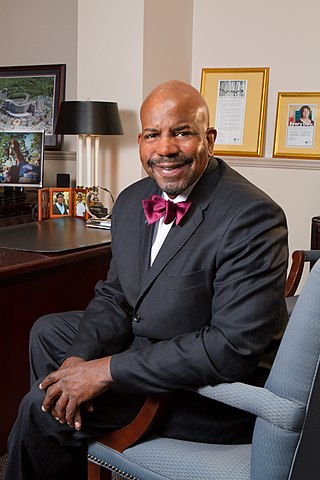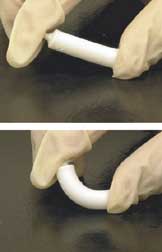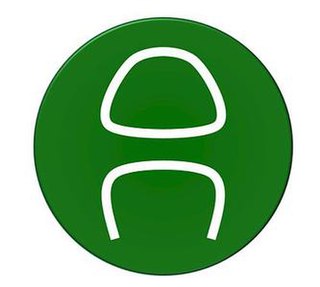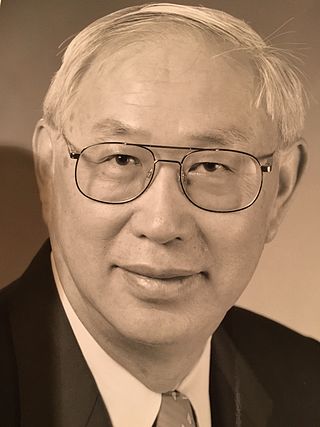Related Research Articles

Biomechanics is the study of the structure, function and motion of the mechanical aspects of biological systems, at any level from whole organisms to organs, cells and cell organelles, using the methods of mechanics. Biomechanics is a branch of biophysics.

Orthopedic surgery or orthopedics is the branch of surgery concerned with conditions involving the musculoskeletal system. Orthopedic surgeons use both surgical and nonsurgical means to treat musculoskeletal trauma, spine diseases, sports injuries, degenerative diseases, infections, tumors, and congenital disorders.

An implant is a medical device manufactured to replace a missing biological structure, support a damaged biological structure, or enhance an existing biological structure. For example, an implant may be a rod, used to strengthen weak bones. Medical implants are human-made devices, in contrast to a transplant, which is a transplanted biomedical tissue. The surface of implants that contact the body might be made of a biomedical material such as titanium, silicone, or apatite depending on what is the most functional. In 2018, for example, American Elements developed a nickel alloy powder for 3D printing robust, long-lasting, and biocompatible medical implants. In some cases implants contain electronics, e.g. artificial pacemaker and cochlear implants. Some implants are bioactive, such as subcutaneous drug delivery devices in the form of implantable pills or drug-eluting stents.

Regenerative medicine deals with the "process of replacing, engineering or regenerating human or animal cells, tissues or organs to restore or establish normal function". This field holds the promise of engineering damaged tissues and organs by stimulating the body's own repair mechanisms to functionally heal previously irreparable tissues or organs.
Biomechanical engineering, also considered a subfield of mechanical engineering and biomedical engineering, combines principles of physics, biology, and engineering. Topics of interest in this field include biomechanics, computational mechanics, continuum mechanics, bioinstrumentation, design of implants and prostheses, etc. This is a highly multidisciplinary field, and engineers with such a background may enter related niche careers, e.g., as an ergonomics consultant, rehabilitation engineer, biomechanics researcher, and biomedical device engineer.

Cato T. Laurencin FREng SLMH is an American engineer, physician, scientist, innovator and a University Professor of the University of Connecticut.
Kyriacos A. Athanasiou is a Greek Cypriot-American bioengineer who has contributed significantly to both academic advancements as well as high-technology industries. He is currently a Distinguished Professor at the University of California, Irvine. He joined UCI from the University of California, Davis where he also served as the Chair of the Biomedical Engineering department. Before joining the University of California in 2009, he was the Karl F. Hasselmann Professor at Rice University. He has published hundreds of scientific articles detailing structure-function relationships and tissue engineering approaches for articular cartilage, the knee meniscus, and the temporomandibular joint.

Artificial bone refers to bone-like material created in a laboratory that can be used in bone grafts, to replace human bone that was lost due to severe fractures, disease, etc.

OrthoCAD Network Research Cell is a federally funded research and development facility in the Indian Institute of Technology Bombay, Mumbai, India. The Laboratory's primary function is the design and development of reconstruction systems for orthopaedic and other applications, the current focus is on mega-implants for limb-saving surgery, mainly for children affected by bone cancer. The Cell later led to the establishment of Biomedical Engineering and Technology (incubation) Centre (BETiC).
Evan Flatow is an American orthopaedic surgeon-scientist. As of 2023, he is President of Mount Sinai West, part of the Mount Sinai Health System. He published more than 400 book chapters and peer-reviewed articles. Flatow is indicated as principal or co-principal investigator for nine research grants and listed on six patents for influential shoulder implant systems.

Van C. Mow is a Chinese-born-American bioengineer, known as one of the earliest researchers in the field of biomechanics.
Andrew Jonathan Carr, FMedSci is a British surgeon and has been the sixth Nuffield Professor of Orthopaedics and head of the Nuffield Department of Orthopaedics, Rheumatology and Musculoskeletal Sciences at the University of Oxford since 2001.
Marjolein Christine Hermance van der Meulen is an American engineer who currently serves as James M. and Marsha McCormick Director of Biomedical Engineering and Swanson Professor of Biomedical Engineering at Cornell University and is a Senior Scientist in the Research Division of the Hospital for Special Surgery.

Robin Sydney Mackwood Ling, was an English surgeon who invented the Exeter hip system, a hip replacement. As an orthopaedic surgeon at the Princess Elizabeth orthopaedic hospital, Exeter, he co-operated with an engineer, Dr. Clive Lee from the University of Exeter, to develop a new hip replacement. Their work led to improved quality of life for millions of people.
Artificial cartilage is a synthetic material made of hydrogels or polymers that aims to mimic the functional properties of natural cartilage in the human body. Tissue engineering principles are used in order to create a non-degradable and biocompatible material that can replace cartilage. While creating a useful synthetic cartilage material, certain challenges need to be overcome. First, cartilage is an avascular structure in the body and therefore does not repair itself. This creates issues in regeneration of the tissue. Synthetic cartilage also needs to be stably attached to its underlying surface i.e. the bone. Lastly, in the case of creating synthetic cartilage to be used in joint spaces, high mechanical strength under compression needs to be an intrinsic property of the material.

Raju Vaishya is an Indian researcher with contributions in the field of orthopaedics. He is former President and founder member of Indian Cartilage Society (2018–19) and Founder President of Arthritis Care Foundation. He has established a center for Autologous Chondrocyte Implantation (ACI) at Indraprastha Apollo Hospitals, New Delhi, India. Instrumental (PSI) in starting the first cartilage club in Delhi, to enhance the awareness about the cartilage science and regenerative treatments used in Orthopaedics. He has the credit of doing the first preplan patient specific instruments (PSI) total knee arthroplasty, in Northern India in May 2013.

Victor Valderrabano is a Swiss orthopedic surgeon and traumatologist specializing in sports traumatology, osteoarthritis surgery and reconstructive surgery of the lower extremity.
Farshid Guilak is an American engineer and orthopedic researcher. He is the Mildred B. Simon Professor of Orthopaedic Surgery at Washington University in St. Louis and director of research at Shriners Hospitals for Children. He is also on the faculty of the departments of Biomedical Engineering, Mechanical Engineering & Materials Science, and Developmental Biology at Washington University.
Justin Peter Cobb is a British professor of orthopaedic surgery at Imperial College London, known for introducing medical robotics into orthopaedic surgery. He is a member of the Royal Medical Household and was royal orthopaedic surgeon to the Queen. He is on the staff at King Edward VII's Hospital (KEVII) and is civilian advisor in orthopaedics to the Royal Air Force (RAF). His research has also included themes relating to designing new devices such as for ceramic hip resurfacing, 3D printing in orthopaedics, and training in surgical skills. He is a director of the MSk laboratory based in the Sir Michael Uren Hub.
Dawn M. Elliott is an American biomedical engineer whose research concerns the biomechanics of connective tissue including the tendons, menisci, and intervertebral discs. She is Blue and Gold Distinguished Professor of Biomedical Engineering at the University of Delaware, adjunct professor of orthopaedic surgery at the Perelman School of Medicine at the University of Pennsylvania, and the former president of the Biomedical Engineering Society.
References
- 1 2 3 4 5 "Home - Professor Jonathan Jeffers". www.imperial.ac.uk. Retrieved 2023-08-30.
- 1 2 "Current NIHR Research Professors". www.nihr.ac.uk. Retrieved 2023-08-30.
- 1 2 "Search - NIHR Funding and Awards". fundingawards.nihr.ac.uk. Retrieved 2023-08-30.
- ↑ "Dr Jonathan Jeffers is first non-clinician to win NIHR Research Professorship | Imperial News | Imperial College London". Imperial News. 2019-09-04. Retrieved 2023-08-30.
- ↑ "Imperial College engineer takes implant tech stateside". Med-Tech Innovation. 2018-05-31. Retrieved 2023-09-02.
- ↑ "Renishaw to Attend Orthopedic Surgeons' Annual Meeting". Robotics Business Review. 2018-03-06. Retrieved 2023-09-03.
- ↑ "Imperial Designed External Fixator Aims to Cater to the High-conflict Regions of the Low and Middle-Income Countries". NIHR Imperial Biomedical Research Centre. Retrieved 2023-09-02.
- ↑ "Researchers Pilot Affordable Device for Fixing Bone Fractures". Medscape UK. Retrieved 2023-09-02.
- ↑ Jeffers, Jonathan RT (9 May 2012). "The role of biomechanics and engineering in total hip replacement. Why surgeons need technical help". Proceedings of the Institution of Mechanical Engineers, Part H: Journal of Engineering in Medicine. 226 (12): 947–954. doi:10.1177/0954411912445735. ISSN 0954-4119.
- ↑ "Our Team - Acellular / smart materials – 3D architecture". UK Regenerative Medicine Platform. Retrieved 2023-09-03.
- ↑ "Spinout company wins funding to 3D print face masks". Imperial News. 2020-05-27. Retrieved 2023-09-03.
- ↑ "Home". www.osstec.uk. Retrieved 2023-08-30.
- ↑ "Companies House entry for Additive Instruments" . Retrieved June 4, 2024.
- ↑ "Pitchbook entry for Additive Instruments" . Retrieved June 4, 2024.